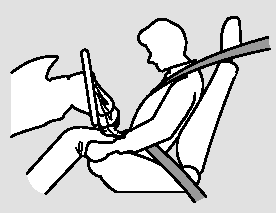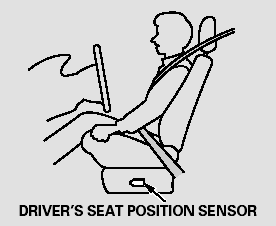 Honda Accord: How Your Front Airbags Work
Honda Accord: How Your Front Airbags Work

If you ever have a moderate to severe frontal collision, sensors will detect the vehicle’s rapid deceleration.
If the rate of deceleration is high enough, the control unit will inflate the driver’s and front passenger’s airbags, at the time and with the force needed.
During a frontal crash, your seat belt restrains your lower body and torso, and the front airbag helps protect your head and chest.
Although both airbags normally inflate within a split second of each other, it is possible for only one airbag to deploy.
This can happen if the severity of a collision is at the margin, or threshold, that determines whether or not the airbags will deploy. In such cases, the seat belt will provide sufficient protection, and the supplemental protection offered by the airbag would be minimal.
Only the driver’s airbag can deploy if there is no passenger in the front seat, or if the advanced airbag system has turned the passenger’s airbag off.

After inflating, the front airbags immediately deflate, so they won’t interfere with the driver’s visibility, or the ability to steer or operate other controls.
The total time for inflation and deflation is one-tenth of a second, so fast that most occupants are not aware that the airbags deployed until they see them lying in their laps.
After a crash, you may see what looks like smoke. This is actually powder from the airbag’s surface.
Although the powder is not harmful, people with respiratory problems may experience some temporary discomfort. If this occurs, get out of the vehicle as soon as it is safe to do so.
Dual-Stage, Multiple-Threshold Front Airbags (SRS)
Your vehicle is equipped with dualstage, multiple-threshold front airbags (SRS). During a frontal crash severe enough to cause one or both front airbags to deploy, the airbags can inflate at different rates, depending on the severity of the crash, whether or not the seat belts are latched, and/or other factors.
Front airbags are designed to supplement the seat belts to help reduce the likelihood of head and chest injuries in frontal crashes.
Advanced Airbags
Your front airbags are also advanced airbags. The main purpose of this feature is to help prevent airbagcaused injuries to short drivers and children or small-statured adults who ride in front.
For both advanced airbags to work properly:
Occupants must sit upright and wear their seat belts properly.
Do not spill any liquids on or under the seats, cover the sensors, or put any objects or metal items under the front seats.
Objects placed or pushed under the front passenger’s seat may cause the sensor to malfunction, increasing the risk of injury in a crash.
Failure to follow these instructions could damage the sensors or prevent them from working properly.

The driver’s advanced front airbag system includes a seat position sensor under the seat. If the seat is too far forward, the airbag will inflate with less force, regardless of the severity of the impact.
If there is a problem with the sensor, the SRS indicator will come on, and the airbag will inflate in the normal manner regardless of the driver’s seating position.

The passenger’s advanced front airbag system has weight sensors under the seat. Although Honda does not encourage carrying an infant or small child in front, if the sensors detect the weight of an infant or small child (up to about 65 lbs or 29 kg), the system will automatically turn the passenger’s front airbag off.
Be aware that objects placed on the passenger’s seat can also cause the airbag to be turned off.
When the passenger airbag gets turned off by the weight sensors, a ‘‘passenger airbag off’’ indicator in the center of the dashboard comes on.
If the weight sensors detect there is no passenger in the front seat, the airbag is automatically turned off.
However, the passenger airbag off indicator in this situation will not come on.
To ensure that the passenger’s advanced front airbag system will work properly, do not do anything that would increase or decrease the weight on the front passenger’s seat.
This includes:
A rear passenger pushing or pulling on the back of the front passenger’s seat.
Moving the front seat or seat-back forcibly back against cargo on the seat or floor behind it.
Hanging heavy items on the front passenger seat, or placing heavy items in the seat-back pocket.
Moving the front seat or seat-back forcibly back against the folded rear seat.
Back seat passengers should not wedge objects or intentionally force their feet under the front passenger seat.
Also, make sure the floormat behind the front passenger’s seat is hooked to the floor mat anchor. If it is not, the mat may interfere with the proper operation of the sensors and operation of the seat.
 Airbag System Components
Airbag System Components
Airbag System Components
Your airbag system includes:
Two SRS (supplemental restraint
system) front airbags. The driver’s
airbag is stored in the center of
the steering wheel; the front
...
 How Your Side Airbags Work
How Your Side Airbags Work
If you ever have a moderate to
severe side impact, sensors will
detect rapid acceleration and signal
the control unit to instantly inflate
either the driver’s or the passenger’s
side a ...
See also:
Audio/Information Screen
Displays the audio status and wallpaper. From this screen, you can go to
various
setup options.
• Switching the Display
Press the (display) button to
change the display.
You can also use ...
Playing an iPod®
Connect the iPod® using your dock connector to the USB port, then select the
iPod
mode.
• How to Select an Album
1. Select the album bar.
- The image of the current album is displ ...
Inboard Joint Side
1. Wrap the splines with on the driveshaft vinyl tape (A)
to prevent damaging the inboard boot.
2. Install the inboard boot onto the driveshaft, then
remove the vinyl tape. Be careful not to dama ...
